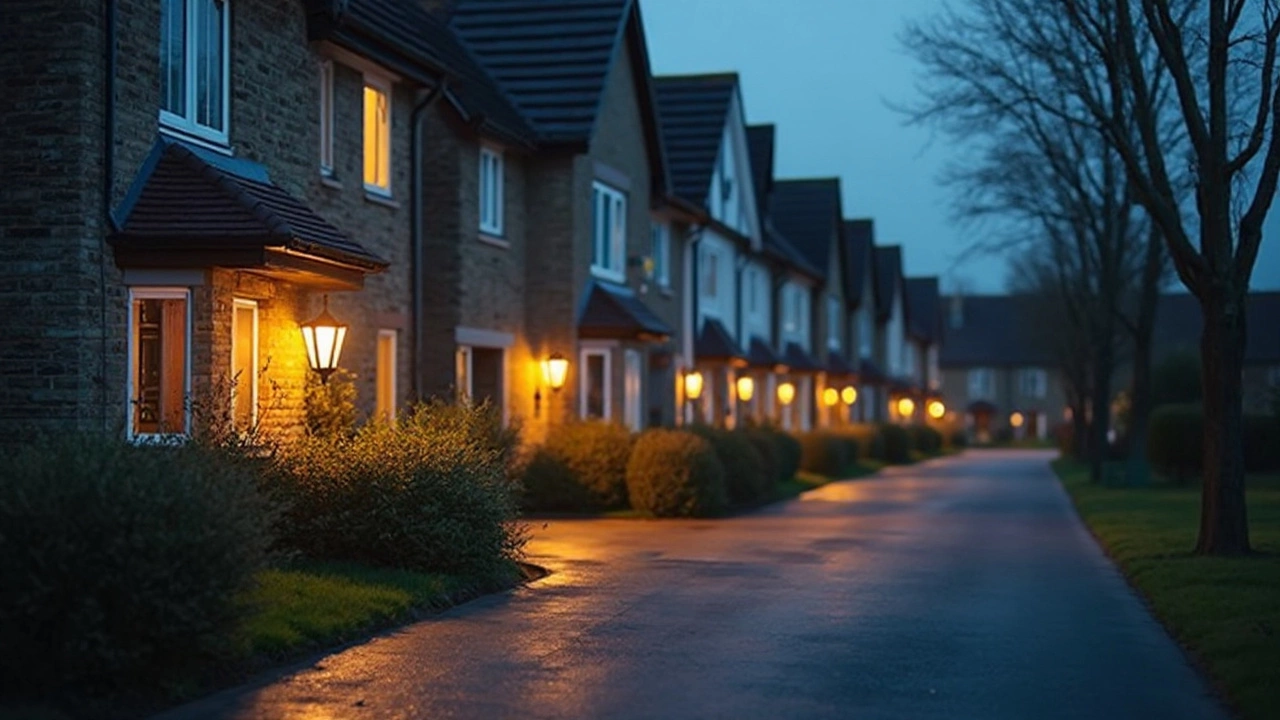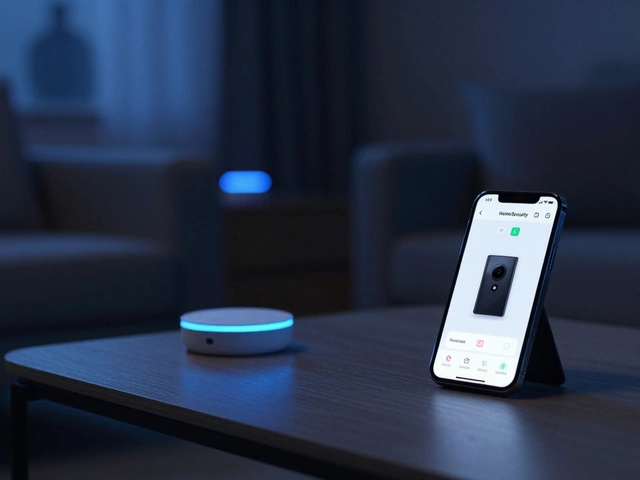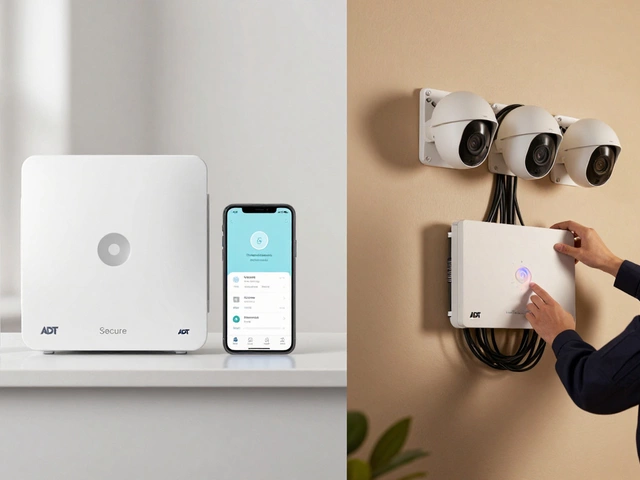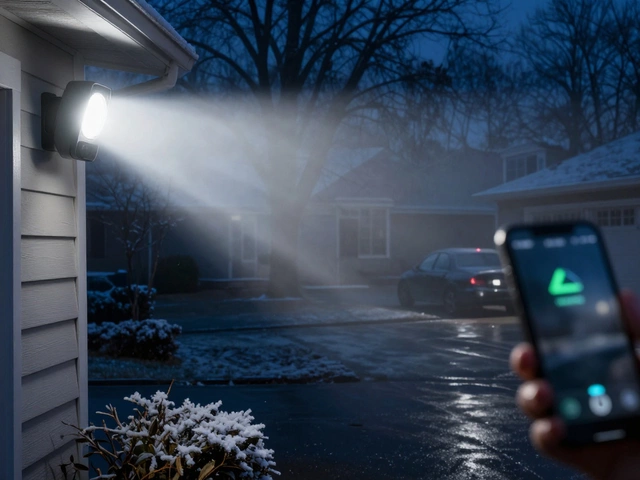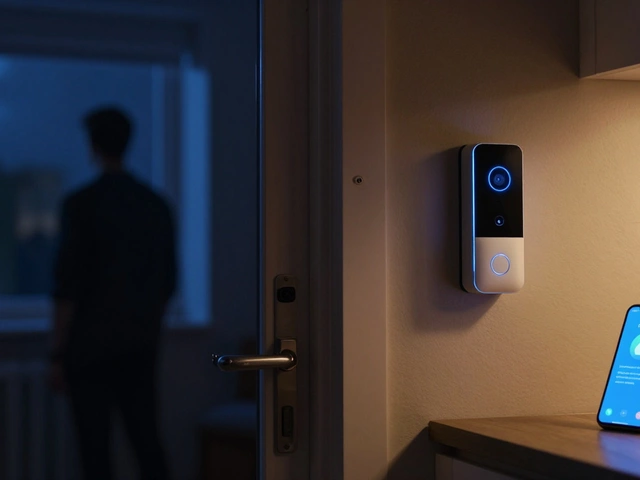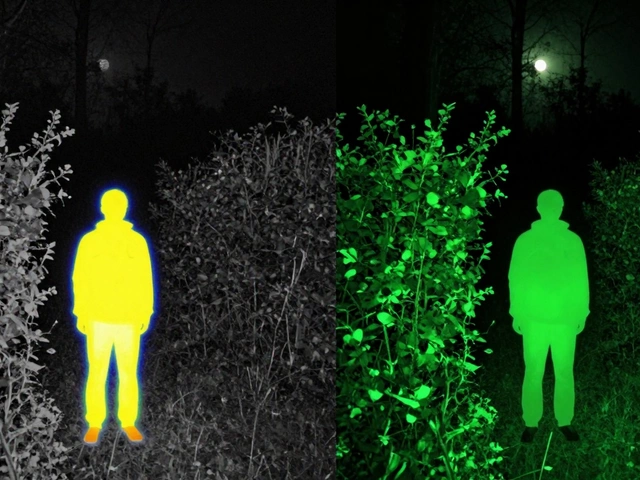When it comes to outdoor security lights, motion sensor lights clinch the top spot for many homeowners. Ever thought about why they're so popular? Well, for starters, they're a breeze to install and don't require hours of fiddling with complicated wiring.
These lights are designed to light up automatically when they detect movement, which is not only a neat trick but also a powerful deterrent for potential intruders. Just imagine stepping into a spotlight whenever you walk to your garage or backyard – thieves don't like that kind of attention.
Another reason they're a hit is their energy efficiency. They stay off until needed, meaning they consume a lot less power than lights that stay on all night. This can lead to some decent savings on your utility bill.
Considering placing these lights around your property? Opt for spots like driveways, front doors, and dimly lit pathways. This strategic placement ensures you cover critical areas without leaving your home looking like a lighthouse.
- Why Motion Sensor Lights Lead the Pack
- Understanding Motion Sensor Technology
- Best Spots for Installing Motion Sensor Lights
- Maintenance Tips for Long-Lasting Performance
- Exploring Advanced Features in Modern Systems
Why Motion Sensor Lights Lead the Pack
When thinking about outdoor security solutions, motion sensor lights often top the list. But what makes them so appealing? It's a mix of efficiency, simplicity, and effectiveness that makes them so prevalent among outdoor security lights.
Energy Savvy and Cost-Effective
One major draw is their energy efficiency. These lights operate only when they detect motion, conserving power and saving you some bucks on your electricity bill. This is a huge reason they're considered the best choice for home safety. Just imagine lighting up your property without the guilt of high energy usage!
Simple Installation, Easy Use
Another perk is the ease of installation. Even if you're not a DIY expert, getting these lights up and running is pretty straightforward. Most motion sensor lights come with clear instructions and don't require fancy tools or an expensive electrician. Position them right, and you're good to go.
Effective Deterrent
Let's face it: the surprise element is powerful. Would-be intruders often retreat when they're suddenly illuminated by a bright light. It's almost like rolling out a welcome mat for them to leave. This psychological impact is what makes these lights top-notch for deterring unwanted visitors.
Flexibility and Coverage
Motion sensor lights are versatile too. Whether mounted above your garage or to illuminate a dark alleyway, they've got you covered. Adjustability features like range and sensitivity settings allow for customization according to your needs and surroundings.
| Feature | Benefit |
|---|---|
| Energy Saving | Reduces electricity bills |
| Simple Installation | No professional help needed |
| Deterrence | Prevents potential break-ins |
When laying out a plan for ensuring your home's safety, it's clear why motion sensor lights are a top contender. From energy savings to effective deterrence, they're an all-in-one solution for upgrading your home's security system.
Understanding Motion Sensor Technology
When you think about motion sensor lights, you're basically dealing with the cool intersection of tech and security. These devices might seem like magic, but there’s some interesting science behind them. At the heart of most motion sensors used in outdoor security lights are either Passive Infrared (PIR) sensors or microwave sensors.
How Do PIR Sensors Work?
PIR sensors are the most common in home security lights. They detect heat changes in their line of sight - that’s you or any other warm-bodied creature walking into the area. When your motion activates the sensor, an electrical signal triggers the light to switch on. This focus on temperature changes keeps the systems simple but effective.
What About Microwave Sensors?
These are a bit different. Microwave sensors send out microwave pulses and read the echoes bouncing back from objects. If there's a change in the signal, boom, it knows something's moved. They can cover a larger area and are less affected by temperature, but they can also be more expensive and complex to set up.
Combining Technologies
Some of the latest systems integrate both technologies for improved accuracy. This combo helps minimize false alarms, like those caused by wind-swayed branches or small animals wandering by. As a bonus, they can offer peace of mind with greater reliability.
Did You Know?
- PIR sensors have a typical detection range of about 10-15 meters. Handy, right?
- In multi-sensor systems, you might find up to 90% fewer false alarms – especially in tricky spots.
Understanding these basics can help you make smarter choices when it comes to picking the right outdoor security lights for your home. Just remember, it’s not just about illuminating the darkness; it’s about smartly lighting it up.

Best Spots for Installing Motion Sensor Lights
Choosing the right spots for your outdoor security lights could make all the difference in keeping your home safe. It's all about coverage and functionality. Let's explore some prime locations that really make these motion sensor lights shine.
Driveways and Garage Entrances
Your driveway is often the first point of entry, making it a prime candidate for motion sensor lights. Position them to cover the driveway and garage entrance so you can be alerted whenever someone approaches your vehicle. Experts say it's like having a virtual welcome mat for wanted guests and a 'Beware' sign for intruders.
Front and Back Doors
The front door is another essential spot. You want to see anyone who steps up to your porch before they even knock. Back doors, often hidden from public view, are also common entry points for burglars. Lighting these areas helps deter any unwanted visitors.
According to John Matthews, a home security expert, "Motion-activated lights are one of the best investments for your home; strategically placing them near entry points can greatly increase your property's security."
Sidewalks and Pathways
Think about the pathways leading to and around your home. Installing motion sensor lights along these routes ensures safe navigation for you and your guests at night while also warding off anyone with ill intentions.
Dark Corners and Blind Spots
Every property has those shadowy corners that seem perfect for hiding. These areas are ideal for additional lighting. Not only do they eliminate blind spots that could be exploited, but they enhance the visibility of your entire yard.
| Area | Importance |
|---|---|
| Driveway | First point of entry |
| Front Door | Main home access |
| Pathways | Safe navigation |
| Dark Corners | Eliminate blind spots |
By thoroughly covering these areas with well-placed lights, you create a network of alerts and deterrents. This way, your home security gets a significant boost, making life much tougher for intruders.
Maintenance Tips for Long-Lasting Performance
Keeping your outdoor security lights in top shape doesn't have to be a chore. A little attention now and then can extend their life and keep your home safe without a hitch.
Regular Cleaning
Start with simple cleaning. Dirt and grime build-up can dim the brightness of your lights. Every few months, take a soft cloth and gently wipe down the lens and sensor of your motion sensor lights. Avoid harsh chemicals as they might damage sensitive parts.
Check and Replace Bulbs
Busted bulbs? Swap them out promptly. Using LED bulbs is a smart choice—they last longer and save on energy. Make sure the wattage matches what your light fixture recommends.
Weather Watch
Outdoor lights face all sorts of weather. After a storm, check for any water or debris that might have snuck into the fixtures. A quick look-over can prevent further damage.
Adjust Sensitivity
Sometimes, your security lights might react to every little rustle. Adjust the sensitivity settings to focus on human or larger movements only.
Inspect Wiring
If you notice flickering, check for loose or frayed wires. Always cut the power before doing any inspections. If you're not comfortable with electrical work, it's best to call in a pro.
Following these simple steps not only keeps your best security lights running efficiently but also maintains the all-important aspect of home safety.

Exploring Advanced Features in Modern Systems
It's pretty amazing how far technology has come, especially with outdoor security lights. These days, advanced features are making them smarter and more versatile. It's not just about turning on when someone walks by; there's a whole tech upgrade happening here.
Integrated Smart Home Connectivity
Many modern security lights now connect seamlessly with smart home systems like Alexa or Google Home. Imagine controlling your lights using just your voice or scheduling them to turn on at sunset automatically, no more fiddling with timers! According to a home automation specialist at Tech Hive, "Integrating smart lighting systems with your home hub adds an extra layer of security that's both intuitive and efficient."
Enhanced Motion Detection Technology
The motion detection tech has also gotten pretty nifty. Some systems use dual sensors to reduce false alarms from, say, a stray cat or heavy winds. This means you get alerted only when there's genuine movement around your house. It's like having a watchdog that never sleeps.
Solar Power Options
Say goodbye to worrying about electrical outlets. A bunch of motion sensor lights now come with solar panels. They soak up sunlight during the day and power your lights at night, which is super eco-friendly and cuts down on energy bills.
"Investing in modern outdoor lighting isn't just about safety; it's about convenience and efficiency," notes Jane Doe, a home safety expert at SafeHouse Insights.
Durability and Weather Resistance
You gotta love a product that can tough it out through rain, snow, or sizzling heat. Today's models often boast weatherproof designs, built to last through harsh conditions without skipping a beat.
Sure, these advanced features might add a bit to the upfront cost, but think of them as investing in peace of mind. Plus, the efficiency and potential savings make them well worth the extra bucks.

